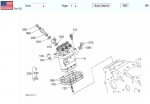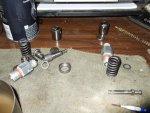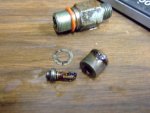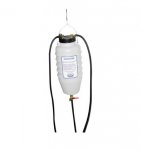I have rebuilt many many D902 engines for RTV's.. All of these suggestions are great.
Always best to go back to the basics. AIR Fuel Compression. I test run every engine, so I have found all kinds of little issues with these little buggers. AIR= remove tube from intake, then like suggested pull valve cover see if valves are moving when turned over. Fuel sucking air in fuel has been a biggie for me it seems like you are getting enough fuel to bleeder but little bits of air keep it from getting enough fuel rail pressure in the injector pumps. even little air bubbles compress not creating enough breaking pressure to lift the pintle of the injector. Lift pump pressure is also another good check. have run into that many times. So now Still on the fuel part...If everything is great to this point, without a injector plunger pressure check gauge, you can take all injector lines off make sure you have fuel to the bleed screw after having messed with it. pull the glow pulgs so it will turn over freely and hit the starter, the fuel shots coming out of the injector pump should shoot over 2-3 ft high or higher or in your eye..then roll it over by hand slowly and watch the fuel come up and crown on top of each fitting. Dab wipe or gently blow the fuel off of the fittings until the little V shaped seating area is empty then roll it over by hand again they should all produce approx the same amount with one revolution. Now compression Book says 456-512 but they will still start at 250 psi with some effort. Timing of the injector pump can't change dramatically like all the sudden unless some thing broke. i.e injecting pump gear or cam or injc pump plungers or rollers. But every one I have rebuilt have to be re timed due to small amounts of wear on all of the above items. Checking and adjusting the timing every 100 hrs will keep you in good trim. I have had a rebuild with the timing off about 8 deg's and low compression due to the rings had not seated, start real hard, but it smoked popped and farted around before I could get it to start. But it started. Checking timing is easy on the bench but in the Machine it is awkward but do able. You have already had the injection pump out so you could easily change the timing. If it comes to that. When you turn the eng over by hand checking fuel delivery at the injc fittings when the fuel just starts to move on plunger #1 stop and pull the rubber plug to see the timing marks on the flywheel. I do it 8 or 9 times, turn the engine real slow and watch really close for the slightest movement. dab the fuel out of #1 until you can see it down in the straight part of the fitting seat but no fuel is in the V part. That makes it easier to see when the fuel starts to move. Remove shims from under injection pump to advance it. which is almost always what you need to do to compensate for normal wear. 17 deg's to 18.5 degs says in book. 19 deg's best power but starts a little harder. Geezz I forgot fuel start spring.. what was I thinking. Had that problem once tooo. Under the cover that has the fuel and stop levers on it is a tiny spring that pulls the rack to the start position. But you can tell if it might be this if you hold it wide open while trying to start it. The timing marks are hard to see, the pointer is just a center punch mark on the backing plate and the flywheel marks are faint, so find them and use metal marker or chalk on them. And by the way the shims under the injection pump look like just one or maybe 2 shims but look real close I always find at least 3 shims stuck together. Book says a .05 mm shim changes the timing about 5 deg's. I always end up pulling more than that to change 5 deg's. Good golly I wrote a book..











 Spud Hauler Thank You! The exploded view of the injector nozzle is perfect but nothing like that for the injector pump. m I worked several hours on Weds only to decide that it was the pump and I would have to step up to the plate if I want to use it anytime soon. I am sending the pump and injectors to Mylex International in Mendenhall,Ms for a rebuild, they have done some great work for me in the past and they have the equipment to make sure it works right. I think the water in the fuel (last summer, a year ago) is finally coming to haunt me. I thank everyone for their help with this. The response has been overwhelming with ideas. It a great site and I will stay tuned in. Thanks Bordercollie! I will use that manual you can count on it.
Spud Hauler Thank You! The exploded view of the injector nozzle is perfect but nothing like that for the injector pump. m I worked several hours on Weds only to decide that it was the pump and I would have to step up to the plate if I want to use it anytime soon. I am sending the pump and injectors to Mylex International in Mendenhall,Ms for a rebuild, they have done some great work for me in the past and they have the equipment to make sure it works right. I think the water in the fuel (last summer, a year ago) is finally coming to haunt me. I thank everyone for their help with this. The response has been overwhelming with ideas. It a great site and I will stay tuned in. Thanks Bordercollie! I will use that manual you can count on it.


